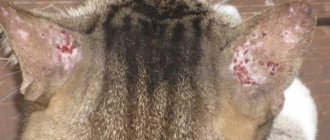Owners of cats that roam freely on the street often encounter problems such as fleas. Small blood-sucking insects easily jump onto animal fur and lay hundreds of eggs on it, from which young individuals hatch within a couple of weeks. In a short time, not only the cat’s body, but the entire apartment becomes a breeding ground for parasites - carriers of dangerous diseases.
Fleas on cats are a pressing problem for many.
What does a flea look like?
The common flea is a blood-sucking insect whose body length is from 3 to 4 mm. The chitinous shell, which protects the flea from damage, is black (in young individuals) or brown (in mature insects) in color. Due to its small size and laterally flattened body shape, the flea maneuvers well between the hairs, moves quickly and easily hides in the animal’s fur.
Each flea's leg has many bristles that provide reliable adhesion to the surface. With the help of long and strong hind legs, the insect makes high (up to 30 cm) and long (up to 50 cm) jumps.
During its life, each flea lays from 300 to 500 eggs, which it hangs on the host's fur in clusters of 5-8 pieces. After 10-14 days, larvae emerge from the eggs, feeding on decomposed organic matter: dead epithelium, debris, dust.
After some time, the larvae pupate. In this state, the insect is protected from any negative influences: water, chemicals, mechanical compression, high and low temperatures, etc. The emergence of an adult from the cocoon occurs only when external conditions are safe and favorable for active life.
An adult flea, regardless of gender, feeds on the blood of its host.
Her “meal” can last from 1 minute to several hours.
Life cycle of a cat flea.
Are fleas dangerous for humans?
Fleas can cause discomfort not only to pets, but also to humans. At times, parasites bother people by biting them, and any fears about this are not unfounded. After the bites of these parasites, unpleasant consequences can be observed on the skin in the form of blisters and papules. In addition, fleas can cause a skin infection in humans, which manifests itself in the form of ulcers or abscesses.
A person can become infected with helminthiasis by accidentally getting cat fleas into their mouth. The disease is asymptomatic in most cases.
Are cat fleas transmitted to humans? This depends on the gender and age of the pet. For example, a kitten's fleas are more likely to be transmitted to humans and begin to bite both the animal and its owner. Fleas are transmitted from cats to humans more often than from cats.
The danger of fleas for a cat and its owner
The flea belongs to the group of ectoparasites, i.e. parasites that live outside the body of their host. By piercing the victim's skin, it does not inject anesthetic substances into the blood, so flea bites are painful for animals. In an effort to relieve discomfort, the cat scratches the affected areas of the body, the skin becomes inflamed and covered with wounds.
Fleas pose the greatest danger to pregnant cats, kittens and pets with chronic diseases. In them, parasites cause anemia, allergies, loss of strength and a weakened immune system.
Fleas are intermediate hosts of some types of worms, including the bovine tapeworm. Therefore, treating pets for fleas should be accompanied by anthelmintic therapy.
In addition, fleas carry some dangerous infections.
Among them:
- encephalitis;
- hepatitis C and B;
- tuberculosis;
- plague;
- typhus;
- brucellosis.
Diseases transmitted by fleas.
What to do if you find a flea?
First of all, there is no need to panic. Parasitic insects are living organisms, which means they can be destroyed. For this purpose, special flea remedies for cats have been developed, which have been tested and successfully used in practice by millions of cat owners.
A brief algorithm of actions if you find parasites on your pet or in your apartment (house):
- if there are few fleas, or your kitten is still very small, then wash the animal with a special shampoo;
- If there are a large number of fleas, the shampoo may not be effective. In this situation, special drops should be used that will either kill the insects or make their offspring unviable. Read more about how to get rid of fleas from a cat in the next section of this article;
- After antiparasitic treatment, it is necessary to disinfest the room(s) where the cat lives. You can learn how to do this in the last section of this article;
- the next step is to eliminate the damage to the animal’s health caused by fleas. You can relieve your cat from itching and speed up the healing of wounds with the help of Miramistin solution. This pharmaceutical product disinfects wounds and has an anti-inflammatory effect; it can be purchased at a regular pharmacy. If you contact your veterinarian, he will prescribe an antihistamine. A visit to the doctor is also necessary if the wounds begin to rot.
Where can a cat get fleas?
Most cases of flea infestation are recorded in stray cats and pets on their own. You can protect them with special means in the form of sprays, drops or collars. But pets can also become victims of blood-sucking parasites.
The sources of infection in these cases are:
- Owner's clothes and shoes. Fleas easily cling to a person’s trousers or shoes outdoors, and once indoors, they move onto the body of a permanent owner. There may also be flea eggs on the soles of your shoes.
- In the summer heat, fleas jump into open doors and windows of private houses or apartments on the ground floor.
- Basements without concrete floor. In such a room, optimal conditions have been created for the proliferation of parasites: dampness, darkness and soft soil. Adult insects easily climb into the house through cracks in the floor.
- Unclean neighbors. Living next to unscrupulous neighbors who do not take care of their pets can cause trouble for the entire neighborhood. The flea colony grows and colonizes new territories, scattering across floors and apartments.
Signs of a pet infection
Most pet owners are interested in how to determine if their cat has fleas? The disease is conventionally divided into several stages. In the first days after infection, the animal’s behavior is not much different from usual. The cat plays with its owners and eats with appetite.
As parasites multiply and their numbers increase, the pet’s behavior changes dramatically. In this case, the following symptoms are observed:
- severe anxiety and increased nervousness;
- frequent scratching;
- plaintive meow;
- disturbed sleep;
- obvious traces of the presence of parasites.
The animal becomes restless and nervous due to severe itching caused by flea bites and skin irritation. Discomfort deprives him of his usual peace and becomes the cause of altered behavior.
The main symptom of fleas in cats is that the pets itch frequently and intensely. As a result of the unpleasant sensations from the bites, cats may bite furiously into the fur, trying to chew out parasites with their teeth.
Wanting to attract the attention of the owner, the animal can give signs in the form of meowing. Thus, the cat shows dissatisfaction with its condition.
Constant bites deprive pets of restful sleep. Animals wake up, begin to itch and get nervous. In an adult or kitten, numerous wounds, red swellings, and blisters appear on the skin.
Note! Fleas do not spend 24 hours a day on their host's body. Together with the body of the infected animal, they actively explore its habitat. Parasites can be found in various parts of the apartment: in upholstered furniture and toys, on carpets, in slippers, on window sills.
Symptoms of flea infestation
To check your cat for fleas, you need to part its fur and examine its skin. Flea bites appear as patches of redness with a black dot in the center. The animal itches frequently, prolonging the healing time of wounds. Since parasites prefer to bite a cat in the abdomen and neck, these areas of the body should be examined especially carefully.
Also a sign of invasion is a white sticky coating on the hairs. These are secretions from the digestive system of insects. And the white grains, similar to salt crystals, stuck to the fur, are flea eggs.
To assess the condition of a cat when diagnosing a parasitic infestation, pay attention to the following symptoms:
- frequent licking of the coat;
- deterioration of appetite and sleep;
- weakness, apathy;
- causeless aggression.
Signs of the presence of parasites are flea excrement on the animal's fur.
Animal behavior assessment
Pain and itching from bites make your pet nervous. The main sign of the presence of fleas is scratching and biting at the sites of parasite attacks. The cat may also wash itself more actively (even to the point of pulling out tufts of fur) and avoid previously favorite resting places:
- own bed;
- upholstered furniture;
- carpets.
All these resting places are potential habitats and breeding grounds for blood-sucking insects. Additionally, their presence can be indicated by helminths in the feces of an animal, which runs the risk of catching them in other ways:
- with raw meat or fish;
- from other animals or people;
- while walking.
The presence of fleas is also indicated by the development of anemia. The disease is characterized by a decrease in the concentration of red blood cells in the blood. This is accompanied by lethargy of the animal and pallor of the mucous membranes.
Fleas provoke the disease by infecting the cat with the bacteria Mycoplasma haemofelis, which destroys red blood cells. A large number of parasites also drink blood faster than the body can restore it. It is difficult not to notice such an abundance of fleas before symptoms of anemia appear.
Anemia caused by physical reasons is more likely to develop in stray animals. Domestic cats are also susceptible to bacterial anemia - all it takes is a couple of fleas that carry the pathogen.
Chemicals against fleas in cats
Pet stores offer a wide selection of flea chemicals based on a combination of insecticidal and repellent substances. Insecticides (Permethrin, Fipronil, Moxidectin, Pyriproxyfen, Etofenprox, Tetrochlorinphos) are toxic substances that have a nerve-paralytic effect on insects. After treatment, they stop moving and quickly die.
Repellents (essential oils of tansy, lemongrass, peppermint, wormwood, margosa extract, geraniol) are substances with a pungent odor that repel parasites. They are included in preparations for kittens, pregnant and lactating cats, and are also applied to flea collars.
Antiparasitic shampoos
Shampoos with an anti-flea effect have a gentle caring effect on your pet's coat, so it can be used for kittens older than 2 months. The advantage of such products is that, under the control of the owner, the animal cannot lick the toxic drug from its body. However, not all cats are relaxed about hygiene procedures.
Anti-flea shampoos are easy to use and are not highly toxic.
Side effects of anti-parasitic shampoos include:
- skin irritation;
- allergy;
- local baldness;
- poisoning if the wool was not washed enough.
The parasite treatment process is as follows:
- Moisten the animal's fur with warm water.
- Squeeze the required amount of shampoo into your palm, lather and apply to the coat.
- Massage and leave the shampoo on the cat's body for 1-3 minutes.
- Rinse the coat thoroughly with shampoo and dry the pet with a towel.
- Comb the dry fur with a fine-toothed comb to remove dead insects.
Flea drops
The simplest, most affordable and effective flea remedy. Drops from a special pipette are applied to the withers, after spreading the fur. Within 2 days after treatment, toxic substances are evenly distributed throughout the cat’s body, accumulating in the sebaceous glands. Over the next month, these substances appear on the skin through natural skin secretions, poisoning existing fleas and repelling others.
Flea drops allow you to quickly get rid of blood-sucking pests.
Anti-flea sprays
Sprays are an effective short-acting anti-flea agent. The effectiveness of 1 treatment lasts for 7 days. If during this period the cat had to be bathed or it got wet in the rain, the procedure will have to be repeated.
It is better to spray the product outdoors, where there is no risk of poisoning people and animals.
Flea collars
A flea collar is a narrow, flexible tape impregnated with repellent and insecticidal substances. It is ineffective in combating existing parasites, but is well suited for preventing their appearance and enhancing the anti-flea effect of other products.
Risk factors
The fleas that infect cats live in the grass. From there they jump on warm-blooded animals and feed on their blood. These blood-sucking parasites live on all continents, even Antarctica. A cat can become infected with fleas at any time of the year.
It is important to remember the reasons why a cat is at risk of contracting parasites:
- A cat that goes outside will definitely become infected with fleas. Therefore, you should not let your pet walk on its own.
- Unlike cats, domestic dogs should be walked 2-3 times a day. If a dog brings fleas home, then all other animals will pick them up. All pets should be treated for fleas regularly.
- A person can bring fleas into an apartment on his shoes or outerwear. Only regular treatment with anti-flea products will protect your pet.
- If the cat already had fleas, but the owner did not treat the pet, then the parasites will soon appear again. Fleas lay eggs in animal fur. New parasites can hatch from these eggs at any time.
- Fleas that have already entered the apartment will settle in the thick carpet. All carpets and cat beds should be thoroughly vacuumed.
- Fleas multiply especially actively in the heat, so in the summer you will have to treat your cat several times.
Flea infestations often lead to serious complications that are detrimental to the health of cats. Flea bites always cause severe pain and excruciating itching, and also provoke the development of dangerous diseases.
Complications of flea bites:
- Anemia is a condition in which a cat does not have enough blood due to a large number of parasites. The level of hemoglobin in the blood is greatly reduced. It develops when cats are not treated for fleas. Street animals are most often affected. Very young kittens, as well as weakened, sick and elderly animals can die from anemia.
- Flea dermatitis is an allergic reaction to the saliva of parasites that enters the skin during a bite. The pet experiences severe skin irritation, so the cat constantly licks. Her hair falls out and her skin becomes crusty. Infection easily penetrates damaged skin, which can lead to blood poisoning.
- Infectious diseases - fleas can infect pets with bartonellosis or rickettsia.
- Tapeworms - by licking, a cat can swallow fleas infected with tapeworms. Because of this, worms will begin to multiply in the intestines, the pet’s well-being will worsen, and then it will have to be treated not only for fleas, but also for worms.
Parasites are especially dangerous for pregnant and lactating cats. Fleas can harm not only the mother, but also the future offspring. But during pregnancy and lactation, you cannot treat your cat with anti-flea agents, because they are toxic. Treatment must be carried out before mating.
Up to 200 fleas can live on one cat. A caring owner should treat pets for parasites 4 times a year - every 3 months. If your cat has fleas, you need to carry out additional treatment.
We recommend the article: Poisonous plants for cats: how to help with poisoning?
How to remove fleas from a small kitten
The high concentration of toxic substances precludes the use of most drugs for kittens under 2 months of age. Restrictions in the choice of products are also imposed on the treatment of pregnant or lactating cats.
If necessary, you can use the traditional method:
- Boil the animal's textiles: bed, bedding, soft toys. This will kill flea eggs, larvae and pupae.
- Dilute 300 grams of table salt in 10 liters of water and bathe your pet in this solution. If there is severe irritation or extensive scratching on the skin, this should not be done. Then the kitten needs to be bathed in a strong decoction of wormwood or a solution of tar soap (¼ bar per 10 liters of water).
- Rinse the coat with warm water, dry with a towel and comb with a comb to remove dead insects.
Actions after detecting and eliminating parasites
After identifying fleas, treating a pet and disinfesting the home, owners need to take care of preventing secondary infestation with parasites. To this end, you should minimize your pet’s contact with stray and street animals, keep the house clean, carefully handle cat accessories (combs, bedding, toilet), and purchase a special flea collar. If you follow these simple rules, the problem of blood-sucking parasites can be solved forever, and your pet will continue to delight its owners with good health and good mood.
Article on the topic: How to remove fleas from a cat?
If you find an error or inaccuracy, please select a piece of text and press Ctrl+Enter.
Apartment processing
An important step in getting rid of parasites is treating the apartment, since 80-90% of flea eggs and larvae are not on the cat, but on household items: carpets, upholstered furniture, cracks in walls and floors, etc. General cleaning and disinfestation of the apartment will allow up to finally solve this problem.
The algorithm is as follows:
- Remove people and pets from the premises. Wear gloves, goggles, and a respirator. Treat furniture, walls and floors with antiparasitic drugs.
- Leave the apartment for 12 hours, and then ventilate it for 2-3 hours.
- Vacuum all surfaces, especially carpets, upholstered furniture, corners, and the floor under furniture.
- Wash and boil soft toys, bed linen, bedspreads, blankets.
- Carry out wet cleaning by adding essential oils of lavender, geranium, pine, tea tree, and eucalyptus to the water.
If necessary, all procedures should be repeated after 3-4 weeks. In this way, not only adult fleas will be destroyed, but also flea eggs.
How to check a cat for fleas and why they are dangerous
If your cat is extremely restless and itches frequently, you should check for parasites:
- pay attention to the fact that the pet is scratching and biting its back and sides;
- by parting the fur, inspect the cat’s skin - the presence of scratches, wounds, and scratches signal danger;
- when combing a cat with a toothed comb, you can easily notice the eggs and excrement of parasites - grains of whitish and black color;
- When bathing a cat, it is easy to detect the insects themselves - they tend to leave the carrier, but cannot move when wet.
If a cat has fleas, immediate measures must be taken to get rid of them.
Infestation is dangerous for your pet for many reasons. In addition to direct itching and anxiety, with an increase in the number of blood-sucking parasites, he may develop serious illnesses:
- allergies - flea saliva contains up to fifteen components that provoke a reaction;
- dermatitis - occurs as a result of allergies;
- helminthic infestation - parasites are usually infected with worm larvae (usually cestodes);
- fungal infection;
- anemia due to blood loss;
- decreased immune defense of the body;
- infectious anemia - hemobartonellosis - when bitten by an infected insect or infection through wounds;
- tularemia is a severe bacterial disease.
If the cat's damage is significant, people are also at risk. Fleas do not live on a person, but even with a single insect bite, he can be infected with many infectious diseases - fungal, helminthiasis, tularemia, typhoid, plague.
There are many preventive measures that can protect your pet and people from the danger of infection. And if fleas have already appeared in the house, then insecticidal treatment of the animal will be the best way to combat the infestation.











